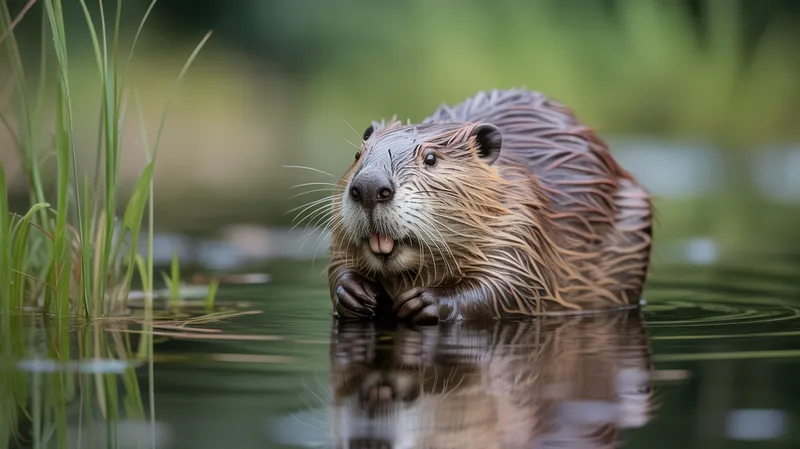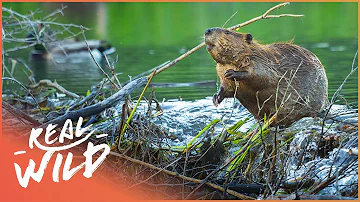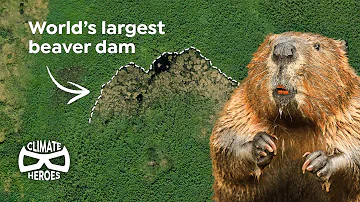
North American Beaver
Castor canadensis

Meet the North American Beaver
The North American Beaver is a large, semi-aquatic rodent renowned for its exceptional dam-building abilities. With its broad, flat tail and prominent orange incisors, the beaver is perfectly adapted to its freshwater environments, where it constructs elaborate lodges and dams using branches, mud, and stones. Beavers play a crucial ecological role by creating wetlands that benefit numerous other species and help regulate water flow. Social and industrious, they live in family groups called colonies and are most active at dusk and nighttime.
Classification
Mammal
Habitat
Freshwater rivers, streams, ponds, and lakes surrounded by forests
Diet
Herbivore
Lifespan
10-15 years in the wild
Conservation
Least Concern
Weight
16-32 kg (35-70 lbs)
📖Fascinating Facts
Ever-Growing Teeth
Beavers' incisors never stop growing, so they must constantly gnaw on wood to keep them trimmed and sharp.
Ecosystem Engineers
By building dams and lodges, beavers create wetlands that provide habitat for many other species and help filter water.
Nocturnal Builders
Beavers are mainly nocturnal, doing most of their construction and foraging at night to avoid predators.
📋Detailed Description
The North American beaver (Castor canadensis) is the largest rodent native to North America, with adults typically weighing between 16 and 32 kg (35–70 lbs), though exceptional individuals can exceed 40 kg (88 lbs). Their robust, stocky bodies are covered in dense, waterproof brown fur, with a thick underfur for insulation and longer guard hairs for protection. The beaver's most distinctive features include a broad, flat, scaly tail used for swimming, balance, and communication, and large, continuously growing orange incisors strengthened by iron-rich enamel. Their hind feet are webbed for efficient swimming, while the front paws are dexterous, adapted for manipulating building materials. Beavers possess specialized nictitating membranes to protect their eyes underwater and valvular nostrils and ears that close when submerged. Highly social, they live in extended family groups called colonies, typically consisting of a monogamous breeding pair, the current year's kits, and yearlings from the previous season. Beavers are renowned ecosystem engineers, constructing dams and lodges from wood, mud, and stones, creating wetlands that enhance biodiversity and water quality. Their lodges, built with underwater entrances, provide protection from predators and harsh weather. Beavers are primarily crepuscular and nocturnal, spending daylight hours in their lodges or underwater. Their diet consists mainly of the bark, cambium, and leaves of deciduous trees such as aspen, willow, birch, and poplar, supplemented by aquatic plants. Beavers play a keystone role in their ecosystems by altering hydrology, increasing habitat complexity, and supporting a diverse array of plant and animal species.
💡 Did you know?
A beaver's dam can be so large it is visible from space; the largest known beaver dam stretches over 850 meters (2,790 feet) in Alberta, Canada.
🔬Research & Sources
Wikipedia Summary
The North American beaver is one of two extant beaver species, along with the Eurasian beaver. It is native to North America and has been introduced in South America (Patagonia) and Europe. The North American beaver is one of the national symbols of Canada and the official state mammal of Oregon and New York. North American (Canadian) beavers are widespread across the continental United States, Canada, southern Alaska, and some parts of northern Mexico.
Last Modified: 6/11/2025
🎭Behavior & Social Structure
North American beavers are highly territorial and mark their territories with scent mounds composed of mud and castoreum, a secretion from their anal glands. They are most active during twilight and nighttime hours, engaging in foraging, dam and lodge maintenance, and social interactions. Beavers communicate through vocalizations, tail slaps on water to signal alarm, and chemical cues. Feeding behavior involves gnawing down trees with their powerful incisors and transporting branches to food caches or construction sites. They exhibit remarkable problem-solving abilities, adjusting dam structures in response to changes in water flow. Social bonds within colonies are strong, with cooperative care of young and shared responsibilities for maintenance tasks. Juveniles, or kits, are taught essential skills by older siblings and parents. Beavers rarely leave the safety of water, relying on their aquatic adaptations to evade terrestrial predators such as wolves, coyotes, and bears.
👶Reproduction & Life Cycle
Beavers are monogamous, forming long-term pair bonds that often last for life. Breeding occurs once annually, typically between January and March, depending on latitude. After a gestation period of about 105–107 days, females give birth to 1–6 kits (average 3–4) in late spring (April–June). Kits are born fully furred, with eyes open, and are capable swimmers within 24 hours. Both parents participate in rearing the young, with older siblings also assisting. Kits nurse for 6–8 weeks but begin sampling solid food within their first week. Juveniles remain with the family for up to two years before dispersing to establish their own territories. Sexual maturity is reached at about two years of age. Reproductive success is closely linked to territory quality and food availability.
🛡️Adaptations & Survival
North American beavers exhibit a suite of physical and behavioral adaptations for semi-aquatic life and woodcutting. Their webbed hind feet and flattened tail provide propulsion and steering in water, while dense fur and a thick layer of subcutaneous fat offer insulation. The beaver's incisors grow continuously, compensating for constant wear from gnawing wood. Their lips close behind the incisors, allowing them to chew underwater without swallowing water. Beavers have a highly developed sense of smell for detecting predators and marking territory. Their ability to fell trees and manipulate building materials is unmatched among rodents, and their dam-building behavior is a unique ecological adaptation that modifies entire landscapes, creating ponds and wetlands that buffer against drought and flooding. Physiologically, beavers can slow their heart rate while diving and store large amounts of oxygen in their muscles and blood, enabling dives of up to 15 minutes.
📚Research Sources
🎨Cultural Significance
The North American beaver holds significant cultural and historical importance. It is a national symbol of Canada, featured on the Canadian nickel and in the country's heraldry, and is the official state mammal of Oregon and New York. Indigenous peoples have long revered the beaver for its industriousness and resourcefulness, incorporating it into folklore, totemic traditions, and as a source of food and materials. The beaver was central to the North American fur trade, shaping patterns of exploration, settlement, and economic development. Today, beavers are celebrated as ecological engineers and are increasingly valued for their role in wetland restoration and climate resilience.
🔬Recent Research & Discoveries
Recent research has focused on the beaver's role as a keystone species and ecosystem engineer, demonstrating that beaver-created wetlands increase biodiversity, improve water quality, and sequester carbon. Studies using remote sensing and ecological modeling have quantified the hydrological impacts of beaver dams, including groundwater recharge and flood mitigation. Genetic analyses have clarified the evolutionary divergence between North American and Eurasian beavers, with evidence of limited hybridization where ranges overlap. Ongoing research is investigating beaver-mediated restoration as a tool for climate adaptation and stream rehabilitation, particularly in arid and fire-affected landscapes. Behavioral studies have documented sophisticated problem-solving and learning abilities, as well as complex social structures within colonies.
🎥Wildlife Videos

The Secret World Of The North American Beaver | Our World
We see him at work, at play and in moments of danger, threatened by human fur trappers, marauding lions and a grizzly bear.
Our World

American Beaver | Awesome Animals
Second only to humans, beavers alter their environment more than any other organism on the planet. These tireless animal ...
Nat Geo Kids

Busy Beavers Build Dam Ahead of Winter | Yellowstone | BBC Earth
Autumn is the busiest time of the year for beavers – dams must be built in order to ensure they can survive the harsh winter ...
BBC Earth

Beaver Lodge Construction Squad | Attenborough | BBC Earth
From the BBC's Life of Mammals documentary series. WATCH MORE: New on Earth: https://bit.ly/2M3La96 Oceanscapes: ...
BBC Earth

Why Do Beavers Build Dams? Nature's Engineers (Wildlife Documentary) | Natural Kingdom | Real Wild
This is the story of Nature's Extreme Machine, the miracle engineer. We study the behavior of the Beaver from Argentina to Alberta ...
Real Wild

This Beaver Dam is So Huge, You Can See It from Space | Climate Heroes
In Canada, a beaver family has built a dam extending 850m – that's more than twice as long as the Hoover Dam. It's so big it can ...
Terra Mater
🌍Habitat Information
The North American Beaver typically inhabits Freshwater rivers, streams, ponds, and lakes surrounded by forests environments. North American Beavers have adapted to their environments with specialized features and behaviors.
Primary Habitat:
Freshwater rivers, streams, ponds, and lakes surrounded by forests
More detailed habitat information will be available soon.
🛡️Conservation Status
The North American Beaver is currently classified as Least Concern. Conservation efforts are crucial for preserving this species for future generations.
Common Threats:
- 🏠Habitat loss and fragmentation
- 🌡️Climate change impacts
- 🎯Hunting and poaching
- 🏭Human-wildlife conflict
⚠️Threats & Conservation Challenges
Historically, North American beaver populations were severely depleted by the fur trade from the 17th to 19th centuries, but they have since rebounded and are now classified as Least Concern by the IUCN. Current threats include habitat loss due to urbanization, water pollution, and conflicts with humans over flooding and tree damage. In some areas, beavers are trapped or relocated to mitigate property damage. Climate change poses emerging challenges by altering hydrological regimes and affecting food resources. Invasive species and disease outbreaks, such as tularemia, can also impact local populations. Despite these challenges, beaver populations remain stable or increasing in most of their range, thanks to legal protections, reintroduction programs, and recognition of their ecological value.
🔬Scientific Classification
Scientific Name
Castor canadensis
Classification Hierarchy
🔍 About Taxonomic Classification
Taxonomic classification is a hierarchical system used by scientists to classify and organize living organisms based on shared characteristics and evolutionary relationships.
The system moves from broad categories (Kingdom) to increasingly specific ones, with each animal's scientific name typically consisting of its Genus and species.
📝Community Notes
Share your observations and insights about the North American Beaver with our community of wildlife enthusiasts.
Join Our Community
Sign in to share your observations and connect with fellow wildlife enthusiasts.
Sign In to ContributeNo community notes yet
Be the first to share your observations about the North American Beaver!
Explore North American Beaver
Select a tab above to learn more about this amazing animal.
📸Photo Gallery
No photos available for this animal yet.
🌟Discover More Wildlife
Continue your journey of discovery with more fascinating animals from our database
